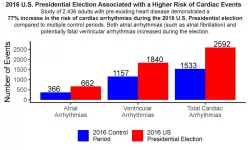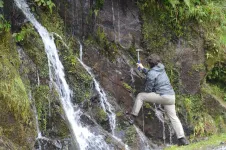Solar geoengineering may be effective in alleviating impacts of global warming on crops
Research offers better understanding of solar geoengineering's effect on agriculture
2021-05-20
(Press-News.org) Solar geoengineering -- putting aerosols into the atmosphere to reflect sunlight and reduce global warming -- is not a fix-all for climate change but it could be one of several tools to manage climate risks. A growing body of research has explored the ability of solar geoengineering to reduce physical climate changes. But much less is known about how solar geoengineering could affect the ecosystem and, particularly, agriculture.
Now, research from the Harvard John A. Paulson School of Engineering and Applied Sciences (SEAS) finds that solar geoengineering may be surprisingly effective in alleviating some of the worst impacts of global warming on crops.
The research, a collaboration with the Norwegian Research Centre and the Bjerknes Centre for Climate Research, the Norwegian University of Science and Technology, the National Center for Atmospheric Research in Boulder, Seoul National University and the Chinese Academy of Sciences, is published in Nature Food.
"Research on solar geoengineering must address whether or not it is effective at reducing human impacts of climate change," said David Keith, the Professor of Applied Physics at SEAS and Professor of Public Policy at the Harvard Kennedy School. "Our paper helps fill that gap by using the best crop model yet embedded in a climate model to examine the potential impact of solar geoengineering on agricultural yields."
The team looked at three types of solar geoengineering -- stratospheric aerosol injection, marine sky brightening, and cirrus cloud thinning -- and their impact on the global yield of maize, sugarcane, wheat, rice, soy and cotton in a business-as-usual future where emissions continue at their current levels.
In such a future, the most effective way to protect crops against the worst effects of global climate change is to reduce the surface temperature. The researchers found that all three potential solar geoengineering methods have a strong cooling effect that would benefit crop yields.
Previous research suggested that cooling temperatures brought on by stratospheric aerosol injection may also lead to less rainfall, which could result in yield loss for rainfed crops. But these studies didn't look at one of the most important ecological factors in crop transpiration and productivity -- humidity.
"Relative humidity or vapor pressure deficit has stronger control on plant water use and crop productivity than precipitation," said Yuanchao Fan, a Fellow in the Harvard Solar Geoengineering Research Program and first author of the paper. "We found that in a cooler world under multiple scenarios, except cirrus cloud thinning, there will be higher relative humidity, which will alleviate water stress for rainfed crops. Our model shows that the change in precipitation resulting from all three solar geoengineering methods would, in fact, have very little effect on crops."
The researchers compared how agricultural productivity is affected by solar geoengineering and emissions reductions. The researchers found that while emissions reductions have strong cooling and humidity benefits, they may have a smaller benefit for crop yields than solar geoengineering because the reduction of CO2 fertilization reduces the productivity of most crops compared with solar geoengineering that achieves the same temperature reduction. The finding highlights the need to combine emissions reductions with other tools, including increasing the use of nitrogen fertilization and changes to land use.
"Climate risks cannot be resolved with any single tool; even if emissions were eliminated tomorrow the world's most vulnerable will still suffer from climate change," said Keith. "Policymakers need to consider how emissions cuts might be supplemented by specific local adaptations to help farmers reduce the impacts of climate on agriculture, and by global actions such as carbon removal and solar geoengineering."
INFORMATION:
The research with co-authored by Jerry Tjiputra, Helene Muri, Danica Lombardozzi, Chang-Eui Park and Shengjun Wu.
The research was supported in part by Harvard University's Solar Geoengineering Research Program.
ELSE PRESS RELEASES FROM THIS DATE:
2021-05-20
CHAPEL HILL, NC - American politics can be stressful and confrontational, which can lead to anger. The combination of intense stress and negative emotions can trigger potentially fatal cardiovascular events in people who are susceptible to these health issues. But the direct link between a stressful political election and an increase in cardiac events hadn't been established, until now. A new study in the Journal of the American Heart Association is the first to show that exposure to a stressful political election is strongly associated with an increase in potentially life-threatening cardiac events.
"This retrospective ...
2021-05-20
A team led by a social work researcher at The University of Toledo has published the first empirical evidence that emotional support animals can provide quantifiable benefits to individuals with serious mental illness who are experiencing depression, anxiety and loneliness.
The research brings credence to the many anecdotal reports of emotional support animals having positive impacts on chronic mental health issues.
"This is the first peer-reviewed, published scientific evidence that emotional support animals may benefit people's mental health," said Dr. Janet Hoy-Gerlach, a professor of social work and the lead investigator on the project. "My hope is that our pilot study catalyzes additional research in this area with more rigorous ...
2021-05-20
FRANKFURT. As first pointed out by the German astronomer Karl Schwarzschild, black holes bend space-time to an extreme degree due to their extraordinary concentration of mass, and heat up the matter in their vicinity so that it begins to glow. New Zealand physicist Roy Kerr showed rotation can change the black hole's size and the geometry of its surroundings. The "edge" of a black hole is known as the event horizon, the boundary around the concentration of mass beyond which light and matter cannot escape and which makes the black hole "black". Black holes, theory predicts, can be described by a handful ...
2021-05-20
When scientists hunt for life, they often look for biosignatures, chemicals or phenomena that indicate the existence of present or past life. Yet it isn't necessarily the case that the signs of life on Earth are signs of life in other planetary environments. How do we find life in systems that do not resemble ours?
In groundbreaking new work, a team* led by Santa Fe Institute Professor Chris Kempes has developed a new ecological biosignature that could help scientists detect life in vastly different environments. Their work appears as part of a special issue of theBulletin ...
2021-05-20
The chemical bisphenol F (found in plastics) can induce changes in a gene that is vital for neurological development. This discovery was made by researchers at the universities of Uppsala and Karlstad, Sweden. The mechanism could explain why exposure to this chemical during the fetal stage may be connected with a lower IQ at seven years of age - an association previously seen by the same research group. The study is published in the scientific journal Environment International.
"We've previously shown that bisphenol F (BPF for short) may be connected with children's cognitive development. However, with this study, we can now begin to understand which biological mechanisms may explain such a link, which is unique for an epidemiological study." ...
2021-05-20
A new study provides public health planning authorities with a method of calculating the number of COVID-19 isolation beds they would need for people experiencing homelessness based on level of infection in the city. The research holds promise for controlling spread of the virus - or future infectious diseases - in a population that is highly vulnerable and less likely than many others to access health care services.
The report, developed to support public health decision-making in Austin, Texas, was recently published by PLOS ONE. The paper's first author is an undergraduate student at The University of Texas at Austin, Tanvi Ingle, who harnessed ...
2021-05-20
In April 2017, a landslide in Mocoa, Colombia, ripped through a local town, killing more than 300 people. Nicolás Pérez-Consuegra grew up about 570 miles north in Santander, Colombia, and was shocked as he watched the devastation on television. At that time, he was an undergraduate intern at the Smithsonian Tropical Research Institute in Panama. As a budding geologist raised hiking the tropical mountains of Colombia, he wondered, what causes greater erosion in some areas of the mountains than in others? And, is it tectonic forces - where Earth's tectonic plates slide against one another leading to the formation of steep mountains - or high precipitation rates, that play a more important role in causing erosion within that region?
To answer those questions would require a geological ...
2021-05-20
Scientists have discovered that the way in which neurons are connected within regions of the brain, can be a better indicator of disease progression and treatment outcomes for people with brain disorders such as epilepsy.
Many brain diseases lead to cell death and the removal of connections within the brain. In a new study, published in Human Brain Mapping, a group of scientists, led by Dr Marcus Kaiser from the School of Medicine at the University of Nottingham, looked at epilepsy patients undergoing surgery.
They found that changes in the local network within brain regions can be a better predictor ...
2021-05-20
More than 90 years ago, astronomer Edwin Hubble observed the first hint of the rate at which the universe expands, called the Hubble constant.
Almost immediately, astronomers began arguing about the actual value of this constant, and over time, realized that there was a discrepancy in this number between early universe observations and late universe observations.
Early in the universe's existence, light moved through plasma--there were no stars yet--and from oscillations similar to sound waves created by this, scientists deduced that the Hubble constant was about 67. This means the universe expands about 67 kilometers per second faster every 3.26 million light-years.
But this observation differs when scientists look at the universe's ...
2021-05-20
BOSTON - Dana-Farber Cancer Institute researchers are presenting dozens of research studies at the 2021 Annual Meeting of the American Society of Clinical Oncology (ASCO). The studies will be presented during the virtual program on June 4-8, 2021. ASCO is the world's largest clinical cancer research meeting, attracting more than 30,000 oncology professionals from around the world.
Toni K. Choueiri, MD, the director of the Lank Center for Genitourinary Oncology at Dana-Farber, will present results from the randomized, double-blind, phase III KEYNOTE-564 trial evaluating pembrolizumab versus placebo after surgery in patients with renal cell carcinoma (abstract LBA5) during ASCO's Plenary Session on Sunday, June ...
LAST 30 PRESS RELEASES:
[Press-News.org] Solar geoengineering may be effective in alleviating impacts of global warming on crops
Research offers better understanding of solar geoengineering's effect on agriculture




